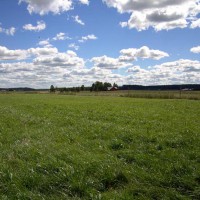The benefits with grassland mixtures

Today our seed mixtures usually contain a mix of maximum four species. Then why is it better to sow mixtures than monocultures? Because there is a positive correlation between species richness and productivity. Here is a summary of some results from a Swedish study that shows the benefits:
A field study was performed in Svalöv, Sweden, with monocultures and four species mixtures of timothy (Phleum pratense L.), English rye grass (Lolium perenne L.), red clover (Trifolium pratense L.) and either chicory (Cichorium intybus L.) or lucerne (Medicago sativa L.). The leys were established year 2007 and harvested three times in 2008 and four times in 2009. They were fertilized with 100 kg N/ha each year.
The results showed that the mixtures gave larger dry matter yield compared to the mean value of all the monocultures. The N concentration in the grasses and chicory was higher in the mixtures than in the monocultures. Fixed legume N was transferred from red clover to mainly the grasses in the mixtures, both legumes also fixed a larger amount of N when they grew in mixtures compared to in monocultures. Read more about how legumes fix N from the air here! The mixtures obtained more N from the soil than the monocultures and light availability for especially the legumes was better in the mixtures than in the monocultures. The legumes and the mixtures formed a denser foliation that let through less light than the grasses and the chicory. Weed presence was, except for English rye grass, less in the mixtures compared to the monocultures. Both the portion of weed in the harvested biomass and the number of weed species in the stand was less in the mixtures. Light influx and the lay’s uptake of N from the soil were the factors that influenced weed portion and number of weed species, the mixtures let through less light to the bottom and obtained more N from the soil which resulted in less weeds.
Mixing the legumes and the grasses led to an increased utilisation of the resources N and light which gave the unwanted weeds less chance to establish. From an environmental point of view it is also beneficial to mix legumes and grasses since the non-fixating plants contribute to decreasing the risk of N leakage from the soil. The authors also concludes that it seems to be necessary using competition strong and high-yielding grasses in the mixed stand for the mixture effect to be large and therefore the matching of species is important. The amount of N fertilization can also influence the mixture effect, when large amounts of N (450 kg/ha) are used the effect of mixing vanishes.
Sara Muhonen, AgrD
